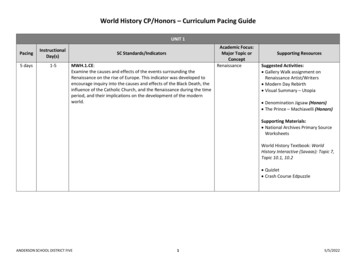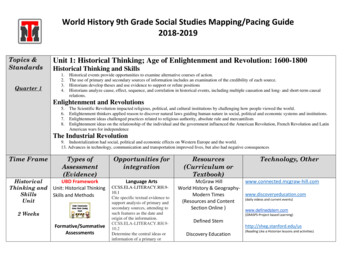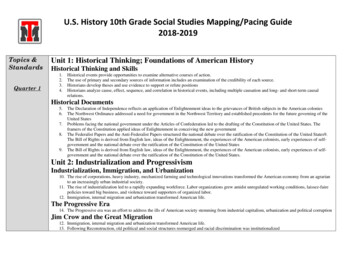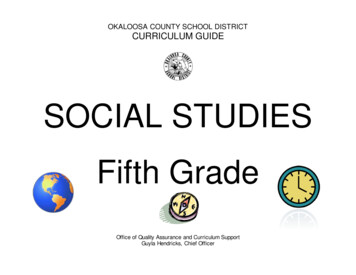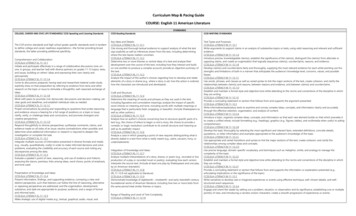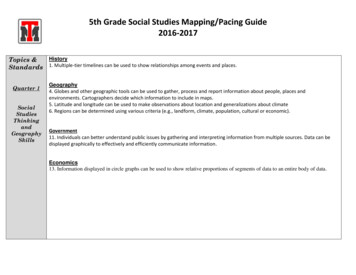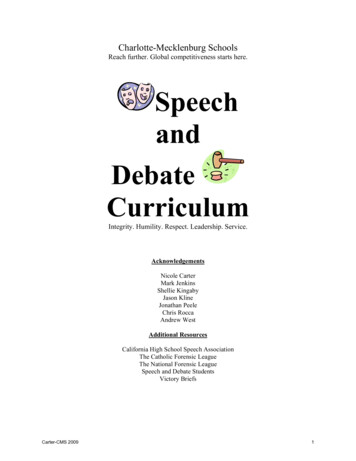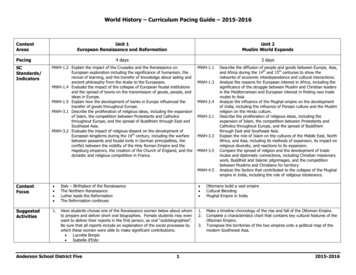
Transcription
World History – Curriculum Pacing Guide – 2015-2016ContentAreasUnit 1European Renaissance and ReformationUnit 2Muslim World Expands4 days3 daysPacingSCStandards/IndicatorsMWH-1.2 Explain the impact of the Crusades and the Renaissance onEuropean exploration including the significance of humanism, therevival of learning, and the transfer of knowledge about sailing andancient philosophy from the Arabs to the Europeans.MWH-1.4 Evaluate the impact of the collapse of European feudal institutionsand the spread of towns on the transmission of goods, people, andideas in Europe.MWH-1.5 Explain how the development of banks in Europe influenced thetransfer of goods throughout Europe.MWH-3.1 Describe the proliferation of religious ideas, including the expansionof Islam, the competition between Protestants and Catholicsthroughout Europe, and the spread of Buddhism through East andSoutheast Asia.MWH-3.2 Evaluate the impact of religious dissent on the development ofEuropean kingdoms during the 16th century, including the warfarebetween peasants and feudal lords in German principalities, theconflict between the nobility of the Holy Roman Empire and theHapsburg emperors, the creation of the Church of England, and thedynastic and religious competition in WH-4.5Describe the diffusion of people and goods between Europe, Asia,and Africa during the 14th and 15th centuries to show thenetworks of economic interdependence and cultural interactions.Analyze the reasons for European interest in Africa, including thesignificance of the struggle between Muslim and Christian leadersin the Mediterranean and European interest in finding new traderoutes to Asia.Analyze the influence of the Mughal empire on the developmentof India, including the influence of Persian culture and the Muslimreligion on the Hindu culture.Describe the proliferation of religious ideas, including theexpansion of Islam, the competition between Protestants andCatholics throughout Europe, and the spread of Buddhismthrough East and Southeast Asia.Explain the role of Islam on the cultures of the Middle East, NorthAfrica, and Asia, including its methods of expansion, its impact onreligious diversity, and reactions to its expansion.Compare the spread of religion and the development of traderoutes and diplomatic connections, including Christian missionarywork, Buddhist and Islamic pilgrimages, and the competitionbetween Muslims and Christians for territory.Analyze the factors that contributed to the collapse of the Mughalempire in India, including the role of religious intolerance.ContentFocus Italy – Birthplace of the RenaissanceThe Northern RenaissanceLuther leads the ReformationThe Reformation continues Ottomans build a vast empireCultural BlendingMughal Empire in IndiaSuggestedActivities1.Have students choose one of the Renaissance women below about whomto prepare and deliver short oral biographies. Female students may evenwant to deliver their reports in the first person, as oral “autobiographies”.Be sure that all reports include an explanation of the social processes bywhich these women were able to make significant contributions: Lucretia Borgia Isabella d’Este1.2.Make a timeline chronology of the rise and fall of the Ottoman Empire.Complete a characteristics chart that contains key cultural features of theOttoman Empire.Transpose the territories of the two empires onto a political map of themodern Southwest Asia.Anderson School District Five13.2015-2016
World History – Curriculum Pacing Guide – 2015-2016ContentAreasUnit 1European Renaissance and Reformation2.3.4.5.6.7.TextbookCorrelationsUnit 2Muslim World Expands Vittoria Colonna Catherine d’Medici Elizabeth I Christine de PizanView the movie The Agony and The Ecstasy to pinpoint key elements ofthe Renaissance such as: Styles of painting and sculpture The patronage relationship Mixing of secular and spiritual authorityDraw a political cartoon to illustrate how the Protestant Reformationcame about from the standpoint of secular authority.Write a short essay describing what the response to a “Martin Luther” inmodern America might be.Write and deliver a “sermon” as a Catholic clergyman strongly opposed toor in favor of Luther’s ideas.Give a speech as Martin Luther explaining his position in relation to thePeasants’ Revolt.Divide the class into three-person teams, each to play the role of HenryVIII, one of his wives, and a marriage counselor. Each “spouse” willstate their complaint against the other and the “counselor” will attemptto outline the basic problems and a possible solution. Be sure to includethe issue of religion whenever applicable.Chapter 17, All sectionsChapter 18, All sectionsWorld History: Patterns of Interaction,World History: Patterns of Interaction,McDougal LittellAnderson School District FiveMcDougal Littell22015-2016
World History – Curriculum Pacing Guide – 2015-2016Unit 3An Age of Explorations and IsolationUnit 4The Atlantic World1492-18004 days5 DaysSCStandards/IndicatorsMWH-1.1 Describe the diffusion of people and goods between Europe, Asia,and Africa during the 14th and 15th centuries to show the networksof economic interdependence and cultural interactions.MWH-2.1 Evaluate the consequences of the changing boundaries ofkingdoms in Europe, Asia, the Americas, and Africa.MWH-2.2 Describe the principle routes of exploration and trade betweenEurope, Asia, Africa, and the Americas from the late 15th centurythrough the 16th century.MWH-2.3 Explain the competition between European kingdoms for spaceand resources, including the Hundred Years’ War between Franceand England, the rise of the Holy Roman Empire in Central Europe,and the response to Islam on the Iberian Peninsula.MWH-2.6 Describe the impact of the competition among European countrieson the various kingdoms of the Americas and Africa, including theColumbian Exchange and the slave trade.MWH-3.6 Analyze various indigenous religions practiced in Africa and theAmericas and their impact on the culture of the region, includinganimism and polytheism.MWH-4.6 Analyze the trade policy of mercantilism and its influence on therelationship between imperial centers and their peripheries.MWH-1.1 Describe the diffusion of people and goods between Europe, Asia,and Africa during the 14th and 15th centuries to show the networksof economic interdependence and cultural interactions.MWH-2.1 Evaluate the consequences of the changing boundaries ofkingdoms in Europe, Asia, the Americas, and Africa.MWH-2.2 Describe the principle routes of exploration and trade betweenEurope, Asia, Africa, and the Americas from the late 15th centurythrough the 16th century.MWH-2.3 Explain the competition between European kingdoms for spacedand resources, including the Hundred Years’ War between Franceand England, the rise of the Holy Roman Empire in Central Europe,and the response to Islam on the Iberian Peninsula.MWH-2.6 Describe the impact of the competition among European countrieson the various kingdoms of the Americas and Africa, including theColumbian Exchange and the slave trade.MWH-3.6 Analyze various indigenous religions practiced in Africa and theAmericas and their impact on the culture of the region, includinganimism and polytheism.MWH-4.5 Analyze the factors that contributed to the collapse of the Mughalempire in India, including the role of religious intolerance.ContentFocus Europeans Explore the EastChina limits European contactJapan returns to isolation Spain builds an American EmpireEuropean nations settle North AmericaThe Atlantic Slave tradeThe Columbian Exchange and Global tradeSuggestedActivities1.2.3.Make a timeline chronology of the rise and fall of the Qing dynasty.Dramatize a short skit in the Kabuki style.Write haikus about World History or current issues.1.Write a first-hand account from the perspective of one of the followingindividuals: a sailor with Columbus or Magellan Bartolome de las Casas Vasco de Gama a native American in the New WorldHave students make a two-column chart listing the various items thatpassed from west to east, and from east to west in the ColumbianExchange.ContentAreasPacing2.Anderson School District Five32015-2016
World History – Curriculum Pacing Guide – 2015-2016ContentAreasTextbookCorrelationsUnit 4The Atlantic World1492-1800Unit 3An Age of Explorations and IsolationChapter 19, All sectionsChapter 20, All sectionsWorld History: Patterns of Interaction,World History: Patterns of Interaction,McDougal LittellAnderson School District FiveMcDougal Littell42015-2016
World History – Curriculum Pacing Guide – nit 5Absolute Monarch in EuropeUnit 6Enlightenment and Revolution4 days4 daysMWH-3.2 Evaluate the impact of religious dissent on the development ofEuropean kingdoms during the 16th century, including the warfarebetween peasants and feudal lords in German principalities, theconflict between the nobility of the Holy Roman Empire and theHapsburg emperors, the creation of the Church of England, andthe dynastic and religious competition in France.MWH-4.1 Explain the changing boundaries in Europe and Asia as a result ofthe competition between nation-states during the 17th and 18thcenturies.MWH-4.7 Explain the disruption within West African kingdoms as a result ofthe competition between European countries over slave H-6.3ContentFocus Spain’s Empire and European AbsolutismReign of Louise XIVCentral European Monarch ClashParliament limits the English monarchAnderson School District Five5Explain the impact of the Crusades and the Renaissance onEuropean exploration including the significance of humanism, therevival of learning, and the transfer of knowledge about sailingand ancient philosophy from the Arabs to the Europeans.Evaluate the impact of the collapse of European feudal institutionsand the spread of towns on the transmission of goods, people,and ideas in Europe.Explain the changes in European overseas empires during thisperiod, including the waning of the Spanish and Portugueseempires and the struggle between empires and colonists.Explain how the scientific revolution in Europe led to thequestioning of orthodox ideas.Analyze the ideas of social equality, democracy, constitutionalism,and nationalism brought about by the Enlightenment and theireffects on institutions.Explain the impact of English political institutions and attitudes ontheir North American colonies, and the American Revolution.Analyze various movements for individual rights, includingworldwide abolitionism, the end of slave trade movements inEngland and Latin America, the liberation of serfs in Russia, andthe growing movement for women’s rights.The Scientific RevolutionEnlightenment in EuropeEnlightenment SpreadsThe American Revolution2015-2016
World History – Curriculum Pacing Guide – 2015-2016ContentAreasSuggestedActivitiesUnit 5Absolute Monarch in Europe1.2.3.4.5.TextbookCorrelationsUnit 6Enlightenment and RevolutionAssign individual students to do short oral thumbnail sketches of each ofthe following monarchs: Philip II Elizabeth I Louis XIV Peter The Great Frederick The GreatReports should focus on the degree of power each had. After hearing allthe reports, let the class decide where to place each monarch on acontinuum drawn on the whiteboard so that the final result shows “leastpowerful” to “most powerful”.Louis XIV called himself the “Sun King” to suggest that all power inFrance radiated from him. Create a “reverse sun” diagram that showsfrom where Louis received all his power. Each “ray” pointing towardLouis should detail a separate source of power, either social, political, oreconomic.Write a short essay arguing whether Louis XIV left a predominantlypositive or a negative legacy to France.Draw six pie charts, one for each English monarch under discussion fromElizabeth I (1558) to William & Mary (1688). With each whole “pie”representing 100% of England’s political power, decide and illustrate howbig a piece belonged to each monarch and how much belonged toParliament.Write a brief essay comparing the political trend in France vs. that ofEngland in terms of monarchs gaining or losing political power.1.2.3.4.Work as two-person teams to graphically illustrate and orally summarizethe key points of the discoveries of the thinkers listed below: Ptolemy Copernicus Kepler Galileo Francis Bacon Descartes NewtonWrite a short essay explaining why there was so much opposition to andconflict over these new ideas of the Scientific Revolution.Lead a class discussion around these central questions: “Why didn’t the Enlightenment take place before the ScientificRevolution?” “What is the specific intellectual concept that connected these twoperiods of achievement?” “What is the modern equivalent, in your opinion, of the ScientificRevolution?”Write a short paragraph linking each of the great Enlightenment thinkerswith any aspect of modern American society.Chapter 21, Sections 1, 2, 3, and 5 (Interim)Chapter 22, All sectionsWorld History: Patterns of Interaction,World History: Patterns of Interaction,McDougal LittellAnderson School District FiveMcDougal Littell62015-2016
World History – Curriculum Pacing Guide – 2015-2016ContentAreasPacingUnit 7French Revolution and NapoleonUnit 8Nationalist Revolutions Sweep the West4 days3 daysSCStandards/IndicatorsMWH-6.2 Analyze the reasons for independence movements as exemplifiedby the French and Haitian revolutions and 18th century SouthAmerican rebellions.MWH-6.3 Analyze various movements for individual rights, includingworldwide abolitionism, the end of slave trade movements inEngland and Latin America, the liberation of serfs in Russia, andthe growing movement for women’s rights.MWH-6.2 Analyze the reasons for independence movements as exemplifiedby the French and Haitian revolutions and 18th century SouthAmerican rebellions.MWH-6.3 Analyze various movements for individual rights, includingworldwide abolitionism, the end of slave trade movements inEngland and Latin America, the liberation of serfs in Russia, andthe growing movement for women’s rights.MWH-6.4 Explain the causes of the revolutions of 1820, 1830, and 1848 andthe reasons why these revolutions failed to achieve nationalist anddemocratic objectives.MWH-6.5 Analyze the successes and limitations of movements for nationalunity, including the unification of Germany and Italy and theAmerican Civil War.ContentFocus French Revolution beginsRevolution brings reform and terrorCongress of Vienna Latin American people win independenceEurope faces revolutionsNationalismSuggestedActivities1.Divide the class in half, one side focusing on the American Revolution,the other on the French. Select a discussion leader for each side tobrainstorm the events, processes, and conditions that led to eachoutbreak. You might even want to sub-divide each half into “Social”,“Economic” or “Political” subgroups to identify these facts by category.Use the groups from the previous activity to identify the social, political,and economic outcomes of these two revolutions. Have the studentswho worked on the American Revolution yesterday work on the FrenchRevolution today, and vice versa.Using the groups and information obtained from the last two activities,lead the class in a discussion around the question: “Why was theoutcome of The French Revolution so much more violent than that of theAmerican Revolution?”1.Assign class members to research and portray the participation of each ofthe personalities below as they pertain to liberation movements in Haiti,Venezuela, Argentina, and Mexico. Try to have each “leader” expressboth sides of the conflict, and be sure to include economic and culturalinfluences, positive and negative, from Europe: Toussaint L’Ouverture Simon Bolivar Jose de San Martin Miguel Hidalgo Jose Maria Morelos King of Spain Prince Don Pedro (Portugal) Napoleon Bonaparte2.3.Anderson School District Five72015-2016
World History – Curriculum Pacing Guide – 2015-2016ContentAreasUnit 7French Revolution and NapoleonUnit 8Nationalist Revolutions Sweep the West2.3.TextbookCorrelationsBrainstorm a list of traits /characteristics that the class feels are distinctly“American” in nature (i.e., “pride”, “stubbornness”, “pioneer spirit”, etc.).Then discuss how these traits have contributed to America’s position inthe world today. Consider also the extent to which this situationwould’ve been different if America had remained part of the BritishEmpire.Compare this process of developing American nationalism with what tookplace in any of the emerging nationalist movements in Europe after 1815.Chapter 23, Sections 1, 2, and 5Chapter 24, Sections 1, 2, and 3World History: Patterns of Interaction,World History: Patterns of Interaction,McDougal LittellAnderson School District FiveMcDougal Littell82015-2016
ContentAreasUnit 9The Industrial RevolutionUnit 10The Age of Democracy and Progress4 days3 daysSCStandards/IndicatorsMWH-5.3 Identify the major technological and social characteristics ofthe Industrial Revolution.MWH-5.4 Analyze the relationship between the expanding world marketeconomy and the development of industrialization in GreatBritain, the United States, Germany, and Japan, includingshifts in world demography and urbanization and changingclass and race relations.MWH-5.5 Compare capitalism with other forms of political andeconomic ideologies, including socialism, communism, andanarchism.MWH-6.5 Analyze the successes and limitations of movements fornational unity, including the unification of Germany and Italyand the American Civil War.ContentFocus Beginnings of Industrial RevolutionIndustrializationIndustrialization SpreadsReforming the Industrial World Democratic reform and activismSelf-rule for British coloniesWar and expansion in the U.S.SuggestedActivities1.Examine the industrializing experience of Great Britain, the UnitedStates, Germany, and Japan. After comparing and contrasting theconditions of each country, answer the question:“What can be concluded about the most important determiningfactors of range and speed of industrialization?”1.Conduct an open class discussion on the topic of anti-Semitism withthe objective of answering the question: “What are the historicalroots of anti-Semitism?” Be sure to include as a minimumdiscussions of the following events: Persecution by and Diaspora from the Roman Empire Blame for the Black Death Spanish Inquisition and expulsion from Spain Attempts of Jews to develop a niche in medieval Europeaneconomy Dreyfus Affair Balfour Declaration (1917) German HolocaustAs a class, construct a Venn diagram to illustrate how unificationmovements in Germany, Italy, and America (during the Civil War)were both similar and different.Pacing2.Anderson School District Five9Midterm ExamWorld History – Curriculum Pacing Guide – 2015-20162015-2016
World History – Curriculum Pacing Guide – 2015-2016Unit 9The Industrial RevolutionUnit 10The Age of Democracy and reate a graphic organizer that illustrates the relationship betweenindustrialization and democratization in 19th century Europe. Besure to include the key events in Great Britain and France thatarose out of the Industrial Revolution and fueled the process ofdemocratization. To decide on the shape of your graphic, thinkabout what happened after democratization began to take hold inEurope in terms of increased or decreased industrialization.Chapter 25, All sectionsChapter 26, Sections 1, 2, and 3World History: Patterns of Interaction,World History: Patterns of Interaction,McDougal LittellAnderson School District FiveMidterm ExamContentAreasMcDougal Littell102015-2016
World History – Curriculum Pacing Guide – 2015-2016ContentAreasUnit 11The Age of ImperialismUnit 12Transformations Around the Globe3 days3 daysSCStandards/IndicatorsMWH-4.7 Explain the disruption within West African kingdoms as a resultof the competition between European countries over slave trade.MWH-5.6 Analyze Asia’s relationship with European states through 1800,including Japan’s policy of limiting contacts with foreigners.MWH-7.5 Explain the impact of collapsing imperial regimes and growingnationalist movements in India, Africa, and Southeast Asia,including Pan-Africanism and the emerging civil rights movementin the United States.MWH-5.4 Analyze the relationship between the expanding world marketeconomy and the development of industrialization in GreatBritain, the United States, Germany, and Japan, including shiftsin world demography and urbanization and changing class andrace relations.MWH-5.6 Analyze Asia’s relationship with European states through 1800,including Japan’s policy of limiting contacts with foreigners.MWH-6.6 Describe the reactions in Asian kingdoms to the Western ideas ofnationalism, including the Indian nationalist movement, the Meijiera in Japan, and the Manchu dynasty in China.ContentFocus The scramble for AfricaEuropeans claim Muslim landsImperialism in Southeast Asia China resists outside influenceModernization of JapanU.S. economic imperialismSuggestedActivities1.Divide the class into groups representing the seven European colonizersof Africa in the 19th century. Have each group research the followingdetails about the African nations colonized by their group’s country: Countries’ names (1913) Countries’ names (2012) Main export (1913) Main export (2012) Year of independence Official non-African languages World ranking by GNP (2012)Compare and contrast the history of European control of Nigeria withthat of South Africa.Construct a cause-and-effect timeline outlining the colonial history ofSouth Africa beginning with the early Portuguese explorers through thearrival of the Boers and then the British.1.Write two letters, one from U.S. President McKinley explaining theOpen Door Policy to the Chinese Empress Cixi, and the secondrepresenting the Empress’ reply. Be sure to mention advantages forChina in the President’ letter, and disadvantages in the Empress’.Draw a diagram illustrating the reforms in China’s government,economy, and society recommended by Empress Cixi. Be prepared toexplain why each reform was a reaction to foreign actions in China.Construct a graphic timeline illustrating Japan’s transformation toisolationism in the early 19th century to militaristic empire in the20thcentury. Focus on key economic and political events that fueled thetransformation.Pacing2.3.Anderson School District Five112.3.2015-2016
World History – Curriculum Pacing Guide – 2015-2016ContentAreasUnit 11The Age of Imperialism4.5.6.7.8.TextbookCorrelationsUnit 12Transformations Around the GlobeOn a blank political map of Eurasia (19th c.), illustrate the flow of tradeof the following goods: raw cotton tea cotton clothing jute peanuts opium coffee indigoWrite a short essay supporting the opinion that India either did or didnot benefit economically and culturally as a result of the British rajView the film The Jewel In The CrownColor a blank outline map of Southeast Asia to represent the Europeannations which colonized these areas.Create an original cartoon that illustrates the growing weakness of theformerly mighty Ottoman Empire against expanding European powers.Use as few words as possible, concentrating instead on the use ofsymbolism and caricature.Chapter 27, Sections 1, 3, and 5Chapter 28, Sections 1, 2, and 3World History: Patterns of Interaction,World History: Patterns of Interaction,McDougal LittellAnderson School District FiveMcDougal Littell122015-2016
World History – Curriculum Pacing Guide – 2015-2016ContentAreasUnit 13The Great WarUnit 14Revolution and Nationalism5 days3 daysSCStandards/IndicatorsMWH-7.1 Analyze the relative importance of economic and political rivalries,ethnic and theological conflicts, social class, militarism, andimperialism as underlying causes of World War I and World War II,including the role of nationalism and propaganda in mobilizingcivilian populations around the world to support the two worldwars.MWH-7.2 Analyze the ways that the responses of the governments of Britain,France, Germany, and Italy to the economic and politicalchallenges of the 1920s and 1930s contributed to the renewal ofinternational hostilities in the years leading o World War II.MWH-7.3 Describe major shifts in world geopolitics between 1900 and 1945,including the changing role of the United States in internationalaffairs and the move from isolationism to an increased role as aworld power.MWH-7.4 Explain the origins of the conflict in the Middle East as a result ofthe collapse of the German, Habsburg, and Ottoman empires afterWorld War I and the creation of the state of Israel after World WarII.MWH-6.6 Describe the reactions in Asian kingdoms to the Western ideas ofnationalism, including the Indian nationalist movement, the Meijiera in Japan, and the Manchu dynasty in China.MWH-6.7 Explain the causes of the Russian Revolution of 1917, including thereasons that the revolutionary government progressed frommoderate to radical.MWH-7.5 Explain the impact of collapsing imperial regimes and growingnationalist movements in India, Africa, and Southeast Asia,including Pan-Africanism and the emerging civil rights movementin the United States.ContentFocus Marching toward warEurope plunges into warA global conflictA flawed peace Revolutions in RussiaImperial China collapsesNationalism in India and Southwest AsiaSuggestedActivities1.Create a grid with all causes of World War I down the vertical axis and allthe participant nations across the top. In each box formed by this grid,indicate with the first letter whether this was a political (P), economic (E),ethnic (H), ideological (I), nationalistic (N), or propaganda (G) concern ofthat particular country.On a blank outline map of Europe in 1914, use a sharply contrastingcolor to draw in the new countries created as a result of World War I.Take note of which pre-war nations gained or lost territory in theprocess, and be prepared to give a fact-based explanation for each.1.Create a 3-section Venn diagram illustrating the common yet differingresponses of Japan, China, and Russia to nationalist impulses.Create a two-tier timeline which documents the key transitional events inChina history from the end of dynastic rule in 1911 through to theCommunist takeover in 1949. Be sure to include social, political, andeconomic influences within China on one tier and correspondinginternational events on the other.Pacing2.Anderson School District Five132.2015-2016
World History – Curriculum Pacing Guide – 2015-2016ContentAreasUnit 13The Great War3.TextbookCorrelationsUnit 14Revolution and NationalismUsing the African nations of Nigeria and Ethiopia as background,attempt to identify and summarize at least one successful andone unsuccessful example of resistance to imperialism in the 19thcentury. Emphasize the common characteristics , if any, in bothsets of examples.3.Create a web diagram with “Bolshevik Revolution” as the central focuscircle. Follow the direct and indirect consequences of this upheaval inthe radiating circles of your diagram. You might even want to considertwo separate diagrams, one for internal Russian results and one forimpacts on international affairs.Chapter 29, All sectionsChapter 30, Sections 1, 3, and 4World History: Patterns of Interaction,World History: Patterns of Interaction,McDougal LittellAnderson School District FiveMcDougal Littell142015-2016
World History – Curriculum Pacing Guide – 2015-2016ContentAreasUnit 15Years in CrisisUnit 16World War II4 days6 daysPacingSCStandards/IndicatorsMWH-7.1 Analyze the relative importance of economic and politicalrivalries, ethnic and theological conflicts, social class, militarism,and imperialism as underlying causes of World War I and WorldWar II, including the role of nationalism and propaganda inmobilizing civilian populations around the world to support thetwo world wars.MWH-7.1 Analyze the relative importance of economic and politicalrivalries, ethnic and theological conflicts, social class, militarism,and imperialism as underlying causes of World War I and WorldWar II, including the role of nationalism and propaganda inmobilizing civilian populations around the world to support thetwo world wars.MWH-7.2 Analyze the ways that the responses of the governments ofBritain, France, Germany, and Italy to the economic and politicalchallenges of the 1920s and 1930s contributed to the renewal ofinternational hostilities in the years leading o World War II.MWH-7.3 Describe major shifts in world geopolitics between 1900 and1945, including the changing role of the United States ininternational affairs and the move from isolationism to anincreased role as a world power.MWH-7.4 Explain the origins of the conflict in the Middle East as a result ofthe collapse of the German, Habsburg, and Ottoman empiresafter World War I and the creation of the state of Israel afterWorld War II.ContentFocus Postwar uncertaintyA worldwide depressionFascism rises in EuropeAggressors invade nations Hitler’s lightning warJapan’s Pacific campaignThe HolocaustThe Allied VictoryEurope and Japan in ruinsSuggestedActivities1.Discuss what life would be like in America today if 40% of thepopulation lost their jobs. Have students follow the step-by-stepdownward spiraling effect of this unemployment, then focus thediscussion on how this cycle could be broken.Compare and contrast the New Deal with measures taken in GreatBritain to respond to the Depression.1.On large outline maps of the world, number and color-code key areasof conflict for the Germans, the Japanese, the British, and theAmericans. On the back of the map, write brief thumbnail summariesof the objectives to be accomplished in each area. Try to keep areasnumbered sequentially and in chronological order, and be sure tomention the geographical facts inherent at each loc
World History - Curriculum Pacing Guide - 2015-2016 Anderson School District Five 4 2015-2016 Content Areas Unit 3 An Age of Explorations and Isolation Unit 4 The Atlantic World 1492-1800 Textbook Correlations Chapter 19, All sections World History: Patterns of Interaction, McDougal Littell Chapter 20, All sections
